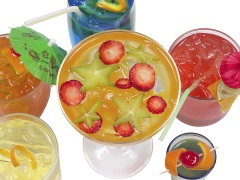Features
Cocktail hour
Date: 2018-06-29 09:22:41.0
Author: Jon Evans

Beta-glucosidase is a critical component of the enzyme cocktails used to convert cellulose and hemicellulose into fermentable sugars for the production of cellulosic biofuels. As a type of cellulase, ꞵ-glucosidase works with two other cellulases to break down cellulose into glucose. It performs the last step in this process, breaking down short chains of glucose, known as cellobiose, into individual glucose molecules.
Because cellobiose inhibits the activity of the other two cellulases, ꞵ-glucosidase determines the efficiency of the whole system: the faster ꞵ-glucosidase can convert cellobiose to glucose, the faster the other two can convert cellulose to cellobiose. Hence scientists are exploring various ways to enhance the activity of ꞵ-glucosidase. As different plant-degrading organisms tend to utilize different variations of ꞵ-glucosidase, one obvious way is to look for new, more efficient variations.
A team of Brazilian scientists led by Flavio Henrique-Silva at the Federal University of São Carlos decided to look for them in an Amazonian lake, as the Amazon is the most biodiverse place on Earth and the lake should contain lots of plant-degrading microbes. This involved conducting a metagenomic study, in which the scientists sequenced all the genes they could find in a sample of the lake. As hoped, one of those genes coded for a novel ꞵ-glucosidase that had never been characterized before.
As Henrique-Silva and his colleagues report in a paper in BBA - Proteins and Proteomics, this novel ꞵ-glucosidase turned out to work best at slightly lower temperatures than many other ꞵ-glucosidases – 40°C rather than 50°C – and was also slightly more tolerant to glucose. They therefore propose that this ꞵ-glucosidase may be ideal for use in simultaneous saccharification and fermentation (SSF) processes, in which the cellulose is broken down and the resultant glucose fermented in a single step. This is because fermenting microbes such as yeast tend to work best at temperatures between 30°C and 45°C.
Lacking easy access to the Amazon, Jason Hallett and his colleagues at Imperial College London in the UK decided to take a different approach, by enhancing an existing, known ꞵ-glucosidase. In particular, they wanted to make ꞵ-glucosidase more robust, so that it could withstand the pretreatment step required to release the cellulose and hemicellulose from plant biomass, prior to their conversion into fermentable sugars. Ordinarily, this pretreatment step involves exposing the biomass to strong acids, which need to be removed before adding the enzyme cocktail, as the acid deactivates the enzymes, but this adds time and expense.
Recently, however, scientists have shown that certain ionic liquids, which are salts that are liquid at room temperatures, can also release cellulose and hemicellulose from plant biomass. Although ionic liquids still deactivate enzymes, and tend to work best at slightly elevated temperatures, Hallett and his team thought they could chemically modify ꞵ-glucosidase so that it would be robust enough to withstand these conditions. In which case, the ionic liquid would no longer need to be removed.
To do this, they encased a conventional ꞵ-glucosidase in a surfactant to produce an enzyme-polymer surfactant nanoconstruct. As they report in a paper in Nature Chemistry, this nanoconstruct could withstand exposure to a range of different ionic liquids at temperatures up to 137°C, with the enzyme remaining active and still being able to convert cellobiose to glucose.
Indeed, the protective surfactant actually enhanced the activity of ꞵ-glucosidase. At a temperature of 110°C in one specific ionic liquid, the nanoconstruct could convert cellobiose to glucose at a rate 30 times higher than normal ꞵ-glucosidase in water. What is more, the nanoconstruct could even convert cellulose directly into glucose molecules, a feat that is impossible for conventional ꞵ-glucosidase.
Hallett says that the same protective approach should also work with other enzymes, potentially leading to a combination of ionic liquid and enzyme cocktail that can convert plant biomass into glucose in a single, highly-efficient step.
The views represented here are solely those of the author and do not necessarily represent those of John Wiley and Sons, Ltd. or of the SCI.
This article has not been tagged with keywords.
